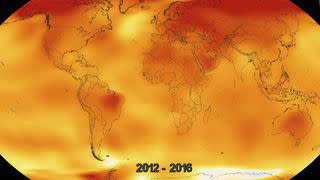How clean energy is transforming the world, in 5 charts

Take it straight from a major fossil fuel supplier: The world's energy mix is changing, and it's shifting toward lower-carbon fuels.
BP, the British oil and gas giant, said global efforts to slash greenhouse gas emissions and boost efficiency are having a tangible effect on global energy markets, with two main narratives playing out: the decline of coal, and the rapid rise of wind and solar power.
SEE ALSO: Apple is investing $1 billion in clean energy with this unique approach
This week, BP released its Statistical Review of World Energy on 2016 data. For 66 years, this annual report has served as an energy industry statistical bible of sorts, painting the broad picture of global energy development.
In an opening letter, BP CEO Bob Dudley stressed the need to "keep our focus and efforts on reducing carbon emissions."
He also voiced support for the Paris Climate Agreement, an international pact that commits nearly all countries to fighting global warming. This puts BP in opposition to President Donald Trump, who on June 1 announced he would withdraw the U.S. from the agreement.
Here are some of the biggest takeaways from BP's annual report:
Renewable energy is the "leading light of the energy transition"

Image: BP statistical review of world energy
Renewable power generation grew by 14.1 percent last year, according to BP, which doesn't include hydropower in this group. While that's slightly below the 10-year average, it's the still the largest annual addition yet.
Solar power in particular jumped 29.6 percent, while wind power grew by 15.6 percent.
Renewables' share of the global energy mix is still fairly small — about 3.2 percent — but last year's strong growth meant that solar, wind, and other sources accounted for nearly one-third of the increase in energy supplies.

Image: BP statistical review of world energy
China was the biggest force in this sector. The world's most populous country and top greenhouse gas emitter contributed more than 40 percent of global renewable energy growth in 2016, which helped it surpass the United States as the largest renewable power producer.
The U.S. isn't likely to reclaim the top spot anytime soon. China is vowing to invest $361 billion in renewables by 2020, yet the Trump administration is doubling down on fossil fuel production, all while criticizing China for not doing enough to control its emissions.
Coal's fortunes have taken "a decisive break from the past"

Image: BP Statistical Review of World Energy
As these charts show, coal has hardly disappeared, and it won't anytime soon. But the coal industry is facing pressure from many sides that are contributing to its long-term decline, BP said.
Natural gas and, to a lesser extent, renewables are replacing coal in the power sector as both become more widely available and cost-competitive. Stronger government limits on carbon emissions in many countries, as well as air and water pollution rules, are also fueling the broader shift away from coal.
However, the biggest near-term factor is, once again, China.
The country last year said it would cancel or postpone plans for 200 coal power plants, and it restricted the number of days that coal mines can operate. The measures are meant to not only reduce toxic urban air pollution and carbon emissions, but also shrink excess capacity in China's coal sector.

Image: BP Statistical Review of World Energy
In 2016, Chinese coal production fell by 7.9 percent — a record drop — while coal consumption declined for the third consecutive year, falling 1.6 percent. Coal prices shot up in response, by 60 percent for thermal coal (the kind used in power plants).
As China is the world's largest coal user, these dynamics spilled over into the global market. Higher global coal prices further depressed coal demand in the power sector, to the benefit of natural gas and renewables.
Global coal consumption slipped by 1.7 percent while production fell by a "whopping" 6.2 percent, BP said. In the U.K., coal supply and demand plummeted to levels not seen since the start of the Industrial Revolution, nearly 200 years ago.
Carbon emissions, and energy demand, are essentially flat

Image: BP statistical review of world energy
We're becoming more efficient in using energy. Global energy markets saw weak growth for the third consecutive year, with energy demand notching up by just 1 percent in 2016. BP credited the "relentless drive to improve energy efficiency" for the deceleration.
Relatively slow economic growth was another factor, including a slowdown in industrial production. All this meant that carbon emissions were essentially flat in 2016, BP said. It's the third consecutive year in which carbon emissions have barely budged from the previous year.
BP's economists said it's unclear whether the past three years signal a "decisive break from the past" that means we're on track to limit global warming — or if the flat emissions are largely driven by cyclical factors that could unwind over time, putting our climate at an even higher risk.
WATCH: It's official, 2016 was Earth's warmest year on record

